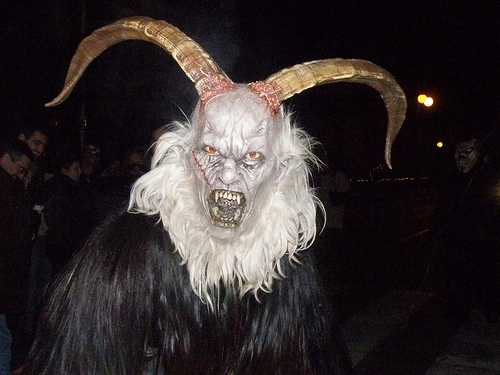KRAMPUS
is a mythical creature recognized in Alpine countries. According to legend, Krampus accompanies Saint Nicholas during the Christmas season, warning and punishing bad children, in contrast to St. Nicholas, who gives gifts to good children. When the Krampus finds a particularly naughty child, it stuffs the child in its sack and carries the frightened child away to its lair, presumably to devour for its Christmas dinner.

In the Alpine regions, Krampus is represented as a beast like creature, generally demonic in appearance. The creature has roots in Germanic folklore. Traditionally young men dress up as the Krampus in Austria, southern Bavaria, South Tyrol, and Hungary during the first week of December, particularly on the evening of 5 December, and roam the streets frightening children with rusty chains and bells. Krampus is featured on holiday greeting cards called Krampuskarten. There are many names for Krampus, as well as many regional variations in portrayal and celebration.

The history of the Krampus figure stretches back to pre-Christian Germanic traditions.
The early Catholic Church discouraged celebrations based around the wild goat-like creatures, and during the Inquisition efforts were made to stamp them out. However, Krampus figures persisted, and by the 17th century Krampus had been incorporated into Christian winter celebrations by pairing him with St. Nicholas.

In the 20th century, Austrian governments discouraged the practice. In the aftermath of the 1934 Austrian Civil War, the Krampus tradition was prohibited by the Dollfuss regime under the the Fatherland Front
(Vaterländische Front) and the Christian Social Party. In the 1950s, the government distributed pamphlets titled "Krampus is an Evil Man".Towards the end of the century, a popular resurgence of Krampus celebrations occurred and continues today.There has been public debate in Austria in modern times about whether Krampus is appropriate for children.
Although Krampus appears in many variations, most share some common physical characteristics. He is hairy, usually brown or black, and has the cloven hooves and horns of a goat. His long pointed tongue lolls out.
Krampus carries chains, thought to symbolize the binding of the Devil by the Christian Church. He thrashes the chains for dramatic effect. The chains are sometimes accompanied with bells of various sizes.

Of more pagan origins are the ruten, bundles of birch branches that Krampus carries and occasionally swats children with. The ruten have significance in pre-Christian pagan initiation rites. The birch branches are replaced with a whip in some representations. Sometimes Krampus appears with a sack or a washtub strapped to his back; this is to cart off evil children for drowning, eating, or transport to Hell.











No comments:
Post a Comment